新标准英语第七册教案大全(一年级起点)
- 格式:doc
- 大小:407.15 KB
- 文档页数:45
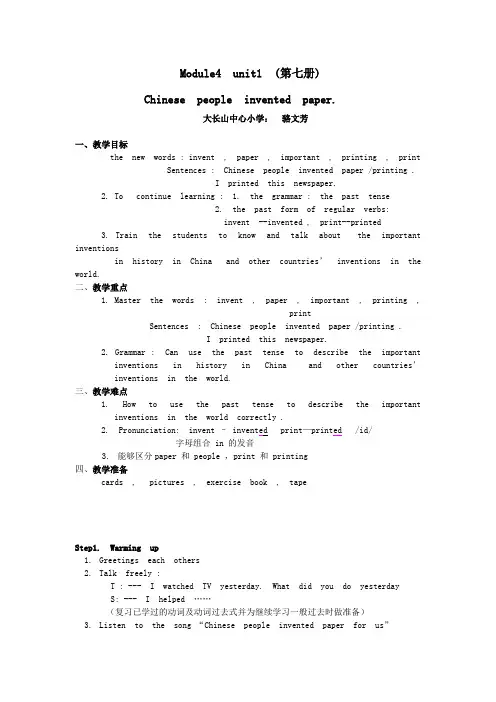
Module4 unit1 (第七册)Chinese people invented paper.大长山中心小学:骆文芳一、教学目标the new words : invent , paper , important , printing , print Sentences : Chinese people invented paper /printing .I printed this newspaper.2. To continue learning : 1. the grammar : the past tense2. the past form of regular verbs:invent --invented , print--printed3. Train the students to know and talk about the important inventionsin history in China and other countries’ invent ions in the world.二、教学重点1. Master the words : invent , paper , important , printing ,printSentences : Chinese people invented paper /printing .I printed this newspaper.2. Grammar : Can use the past tense to describe the importantinventions in history in China and other countries’inventions in the world.三、教学难点1. How to use the past tense to describe the importantinventions in the world correctly .2. Pronunciation: invent – invented print—printed /id/字母组合 in 的发音3.能够区分paper 和 people ,print 和 printing四、教学准备cards , pictures , exercise book , tapeStep1. Warming up1.Greetings each others2.Talk freely :T : --- I watched TV yesterday. What did you do yesterdayS: --- I helped ……(复习已学过的动词及动词过去式并为继续学习一般过去时做准备)3.Listen to the song “Chinese people invented paper for us”Step2. Presentation1.Show some things made of paper and ask and answer :a. paper plane / paper flowerT: -- Look , What’s thisS: -- It’s …….T: -- What’s made ofS: -- teach)T: --- What’s made ofS: --- It’s made of paper.呈现:printing2. As we know , we need paper . paper is important for people呈现(invention / inventor)Tell me : Do you know other inventions in the worldSs: printing , gun—powder , compass and paper are the four inventions by Chinese.Ss: phone , plane are foreign inventions.Ok! Let’s know the inventions in history in China.Step3. Text- teaching1. Look at the picture and listen to the tape with the questions.Who important thingspaperChinese People invented printing( clever ) compassgun-powder(four)(头像) : I printed this newspaper.2.Follow me and read the sentences on the blackboard.3.listen and repeat the text.Step4. Practice1. Finish Part 3.2. Listen to the tape and finish the exercise book.3. Repeat the text and retell it ,then fill the blackboard.Step5. Sum upT: What have you known about inventions in China.1. Chinese people invented paper/ printing/compass/gun-powder.2. wordsOk! Do you know foreign inventions We’ll learn them next lesson.Step6. Homework1.Words : invent(ed) /invention / inventor , paper , important ,printing , print (ed): Chinese people invented paper /printing .I printed this newspaper.3. Retell the text.。
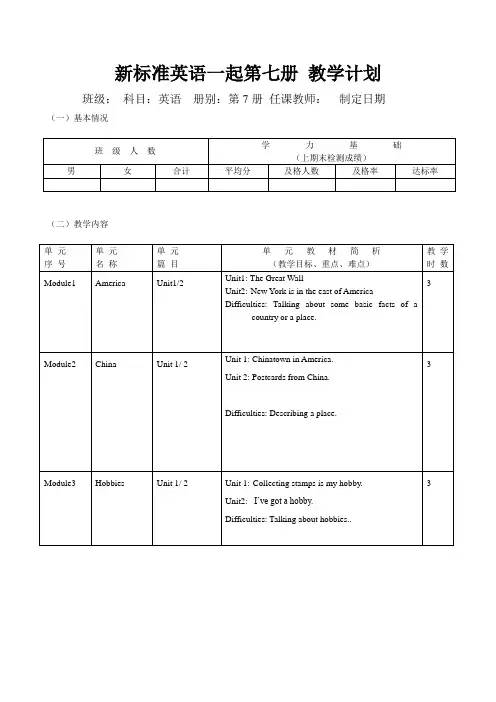
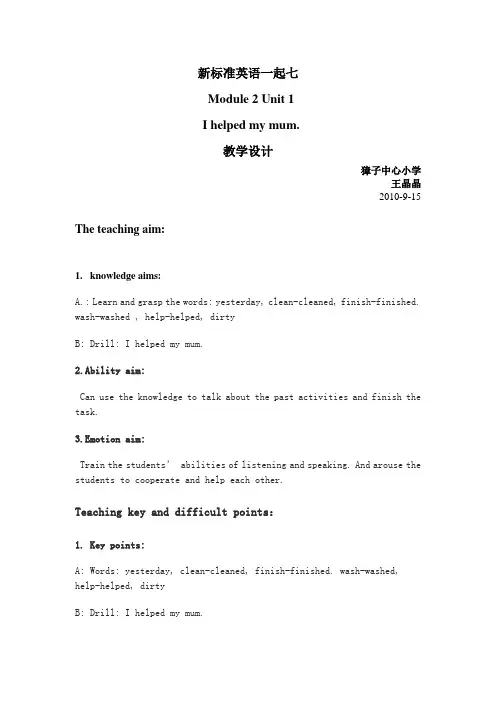
新标准英语一起七Module 2 Unit 1I helped my mum.教学设计獐子中心小学王晶晶2010-9-15 The teaching aim:1.knowledge aims:A.: Learn and grasp the words: yesterday, clean-cleaned, finish-finished. wash-washed , help-helped, dirtyB: Drill: I helped my mum.2.Ability aim:Can use the knowledge to talk about the past activities and finish the task.3.Emotion aim:Train the students’ abilities of listening and speaking. And arouse the students to cooperate and help each other.Teaching key and difficult points:1.Key points:A: Words: yesterday, clean-cleaned, finish-finished. wash-washed, help-helped, dirtyB: Drill: I helped my mum.C: Help the students use the knowledge to talk about the past activities and finish the task.D: Help the students know how to change the regular verbs to the corresponding past verbs---"-ed".2.Difficulties:The pronunciation of "-ed".Preparation for teaching:Word cards, CAI ,CD-ROMThe teaching processⅠ.WarmerGreeting and Review some phrases.Ⅱ.PresentationT: What did he/ she do? And help the students answer with PPT.Ⅲ.Practice1.T: What did Daming do?Help the students listen and try to answer the question.In this way to learn the target languages and take care of the pronunciation of “-ed”.2.Ask the students to open the book, and then listen and think about“When did Daming do these things?”--------Learn the new word“yesterday”.3.Listen and repeat the text.Ⅳ.Production1.Show the reading about the text.2.Practice the Past Tensea)Listen and sayb)Identify the languages.c)Look and say with PPTⅤ.Summary and homework1.Sum up today’s learning.2.Have a test.3.Homework:a)Copy the target languages three times.b)Read the text.c)Recite the words: yesterday, finish, wash, dirty.d)Thinking about a questions: How to read “painted”.板书M 2 U 1clean ed my room.finish edI wash edmy trousers. help edmy mum.。
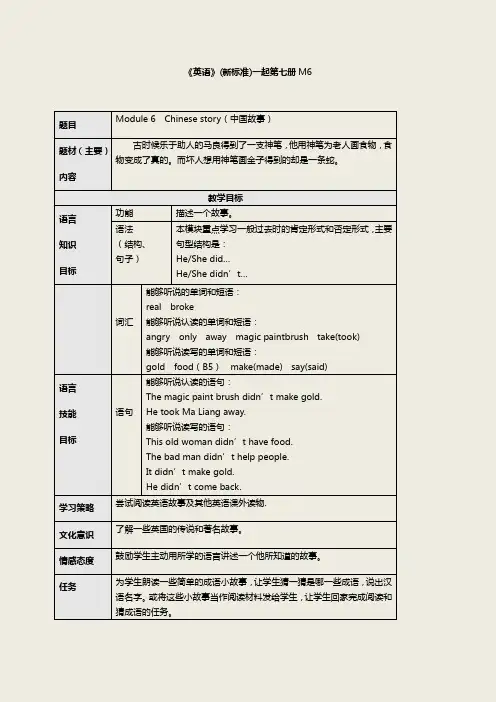
《英语》(新标准)一起第七册M6 题目Module 6 Chinese story(中国故事)题材(主要)内容古时候乐于助人的马良得到了一支神笔,他用神笔为老人画食物,食物变成了真的。
而坏人想用神笔画金子得到的却是一条蛇。
教学目标语言知识目标功能描述一个故事。
语法(结构、句子)本模块重点学习一般过去时的肯定形式和否定形式,主要句型结构是:He/She did…He/She didn’t…词汇能够听说的单词和短语:real broke能够听说认读的单词和短语:angry only away magic paintbrush take(took)能够听说读写的单词和短语:gold food(B5)make(made) say(said)语言技能目标语句能够听说认读的语句:The magic paint brush didn’t make gold.He took Ma Liang away.能够听说读写的语句:This old woman didn’t have food.The bad man didn’t help people.It didn’t make gold.He didn’t come back.学习策略尝试阅读英语故事及其他英语课外读物.文化意识了解一些英国的传说和著名故事。
情感态度鼓励学生主动用所学的语言讲述一个他所知道的故事。
任务为学生朗读一些简单的成语小故事,让学生猜一猜是哪一些成语,说出汉语名字。
或将这些小故事当作阅读材料发给学生,让学生回家完成阅读和猜成语的任务。
Module 6 Unit 1 It didn’t make gold.一、教学目标与要求:1. Be able to listen, speak, read the new words such as “paintbrush, magic, real,gold, took, made.”And the sentences “This old woman didn’t have food. The bad man didn’t have gold. But it didn’t make gold. It made a snake.”2. Be able to listen and repeat the story. Encourage them to retell the story with thehints3. Be able to learn from Ma Liang and help each other.二、教学重点与难点:Key points: The key words and sentencesDifficult points: Be able to listen and repeat the story. Encourage them to retell the story with the hints三、课前准备:vcd powerpoint flash cards tape recorder四、教学过程:一、Warm-UpLet’s sing a song from Module 4.二、Reviewhelp-helped /t/paint-paintedinvent-invented /id/print-printedis-was are-were have-hadmake-made take-took三、Presentation1.Let Ss talk about Ma Liang with their own words.2. Watch the screen and learn the new words: paintbrush, magic, real.Encourage them to say “He had a paintbrush. It was magic. It was real.”3. Watch the whole story and then answer who is the main character except Ma Liang. Teacher put the pictures on the blackboard.4. Listen and cilcle. P1-P3First, the teacher gives the students two questions. Then watch the video. At last, the students choose the right answers.⑴Ma Liang was a ________ boy.A. goodB. bad⑵Did he help people?A. Yes, he did.B. No, he didn’t.5. Listen and fill in the blank. P3Let’s see the old woman.This old woman didn’t have food. So Ma Liang painted food. Then the food was real. Ask several students say the answers and then together.6. What about the bad man? Please watch the video and then answer my questions. First, show the two questions to the students.P4 Did the bad man help people?He didn’t help people.What did he do?He took Ma Liang’s magic paintbrush.take-took Teacher do the actions and let the students understand the meaning of took. 7. Compare P5 with P3. Then fill in the blank.P3: This old woman didn’t have food. So Ma Liang painted food. Then the food was real. P5: The bad man didn’t have gold. So he painted gold with the magic paintbrush.Give them several minutes to prepare and then fill in the blank. I’ll choose one complete Ma Liang, another one complete the bad man. At last, everybody read after them.8. T eacher asks “Did the paintbrush help the bad man? Did it make gold?Teacher will point to the gold and then make a snake.P6: But it didn’t make gold. It made a snake.make-made四、Practice1. Listen, repeat and find “didn’t.”And then read the sentences with “didn’t.2. Read the story in your pairs. One of them can read Ma Liang. Another one can read the bad man.3. Read and tick. (Activity Book P22①)Let the students do it themselves and then check the answers.4. Listen and retell the pictures.Play the tape and then let the students retell what they heard picture by picture.5.Look at the blackboard and retell the story with the hints in your group.First, the teacher retells the story with the hints. And then give them several minutes to prepare. They can choose the pictures in their group. At last, the teacher choose 1 or 2 groups to show.五、ConsolidationI’ll give them several pictures without the book about Ma Liang and ask them to say with their own words.六、Sum-upWhat do you learn from Ma Liang? Let the students sum up with their own words. And then sum up together.We should learn from Ma Liang.We should help each other.七.Homework:1.After class, everyone should retell the story to your parents.2. Activity Book Part 2八.Bb. design:Module 6Unit 1 It didn ’t make gold.a good boy a bad boyhelped people didn ’t help people tookModule 6 Unit 2 He didn ’t come back.青岛惠水路小学 张艳艳一、教学目标与要求㈠ 知识与能力目标知识目标:1、能够听说认读angry, only, took away,He took Ma Liang away.2、 能够听说读写say (said)He didn ’t come back.能力目标:paintbrush magic This old woman didn ’t have food.painted real But it didn ’t make gold.It made a snake.goldpainted引导学生用一般过去时的肯定形式和否定形式,为大家讲一些英文的小故事。
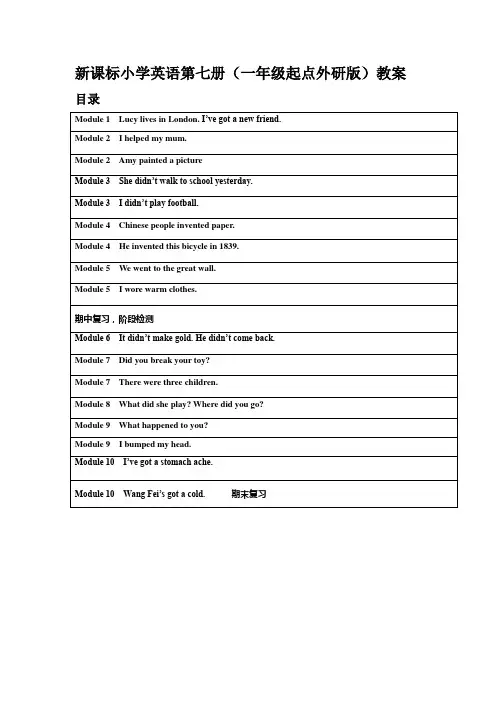
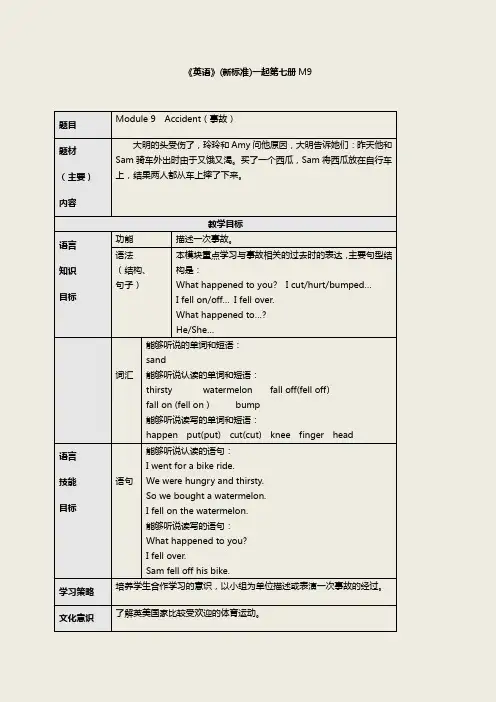
《英语》(新标准)一起第七册M9 题目Module 9 Accident(事故)题材(主要)内容大明的头受伤了,玲玲和Amy问他原因,大明告诉她们:昨天他和Sam骑车外出时由于又饿又渴。
买了一个西瓜,Sam将西瓜放在自行车上,结果两人都从车上摔了下来。
教学目标语言知识目标功能描述一次事故。
语法(结构、句子)本模块重点学习与事故相关的过去时的表达,主要句型结构是:What happened to you? I cut/hurt/bumped…I fell on/off…I fell over.What happened to…?He/She…词汇能够听说的单词和短语:sand能够听说认读的单词和短语:thirsty watermelon fall off(fell off)fall on (fell on ) bump能够听说读写的单词和短语:happen put(put) cut(cut) knee finger head语言技能目标语句能够听说认读的语句:I went for a bike ride.We were hungry and thirsty.So we bought a watermelon.I fell on the watermelon.能够听说读写的语句:What happened to you?I fell over.Sam fell off his bike.学习策略培养学生合作学习的意识,以小组为单位描述或表演一次事故的经过。
文化意识了解英美国家比较受欢迎的体育运动。
情感态度培养学生助人为乐、团结互助的品质。
任务让学生以An Unlucky Day为题,编一个小故事,介绍某人不走运的一天。
Module 9 Unit 1 What happened to you?一、教学目标与要求:1.知识与能力目标Words: happened put(put) , thirsty, fell on , fell offStructure: T alking about a past accident.知识目标(1)掌握四会单词和句型结构。
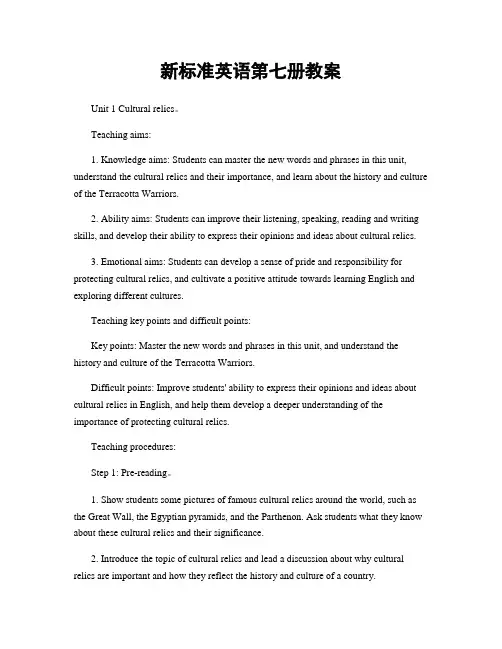
新标准英语第七册教案Unit 1 Cultural relics。
Teaching aims:1. Knowledge aims: Students can master the new words and phrases in this unit, understand the cultural relics and their importance, and learn about the history and culture of the Terracotta Warriors.2. Ability aims: Students can improve their listening, speaking, reading and writing skills, and develop their ability to express their opinions and ideas about cultural relics.3. Emotional aims: Students can develop a sense of pride and responsibility for protecting cultural relics, and cultivate a positive attitude towards learning English and exploring different cultures.Teaching key points and difficult points:Key points: Master the new words and phrases in this unit, and understand the history and culture of the Terracotta Warriors.Difficult points: Improve students' ability to express their opinions and ideas about cultural relics in English, and help them develop a deeper understanding of the importance of protecting cultural relics.Teaching procedures:Step 1: Pre-reading。
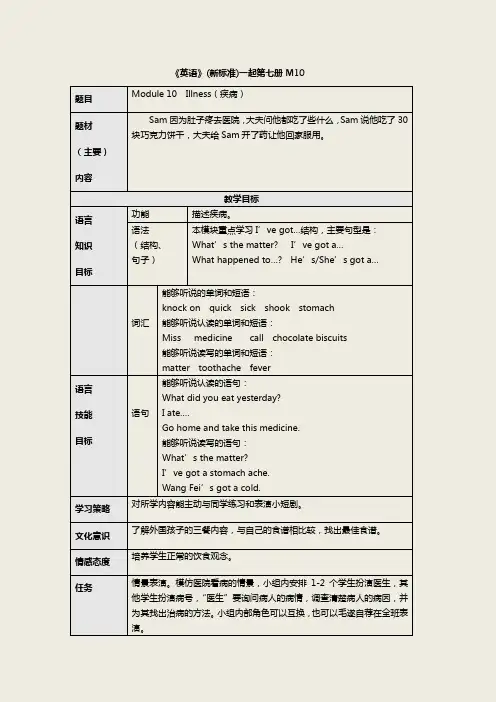
《英语》(新标准)一起第七册M10题目Module 10 Illness(疾病)题材(主要)内容Sam因为肚子疼去医院,大夫问他都吃了些什么,Sam说他吃了30块巧克力饼干,大夫给Sam开了药让他回家服用。
教学目标语言知识目标功能描述疾病。
语法(结构、句子)本模块重点学习I’ve got…结构,主要句型是:What’s the matter? I’ve got a…What happened to…? He’s/She’s got a…词汇能够听说的单词和短语:knock on quick sick shook stomach能够听说认读的单词和短语:Miss medicine call chocolate biscuits能够听说读写的单词和短语:matter toothache fever语言技能目标语句能够听说认读的语句:What did you eat yesterday?I ate….Go home and take this medicine.能够听说读写的语句:What’s the matter?I’ve got a stomach ache.Wang Fei’s got a cold.学习策略对所学内容能主动与同学练习和表演小短剧。
文化意识了解外国孩子的三餐内容,与自己的食谱相比较,找出最佳食谱。
情感态度培养学生正常的饮食观念。
任务情景表演。
模仿医院看病的情景,小组内安排1-2个学生扮演医生,其他学生扮演病号,“医生”要询问病人的病情,调查清楚病人的病因,并为其找出治病的方法。
小组内部角色可以互换,也可以毛遂自荐在全班表演。
Module 10 Unit 1 I’ve got a stomach ache.一、教学目标与要求1.知识与能力目标知识目标:能够听说读写语句:What’s the matter? I’ve got a stomach ache.和单词matter能力目标:能够在医院与医生进行简单的交流。
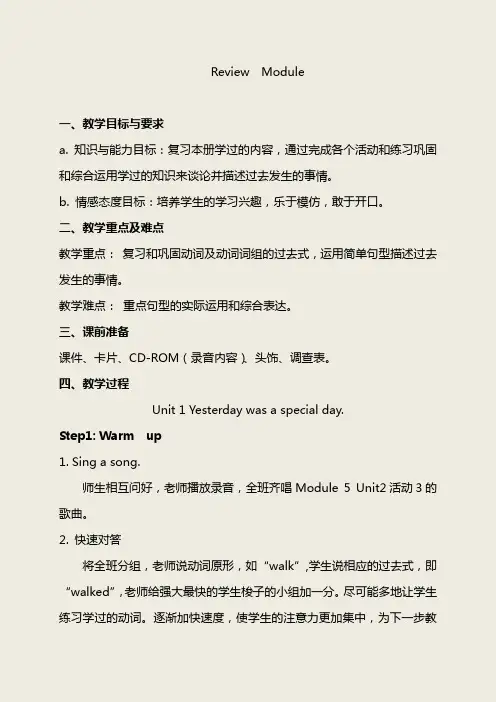
Review Module一、教学目标与要求a. 知识与能力目标:复习本册学过的内容,通过完成各个活动和练习巩固和综合运用学过的知识来谈论并描述过去发生的事情。
b. 情感态度目标:培养学生的学习兴趣,乐于模仿,敢于开口。
二、教学重点及难点教学重点:复习和巩固动词及动词词组的过去式,运用简单句型描述过去发生的事情。
教学难点:重点句型的实际运用和综合表达。
三、课前准备课件、卡片、CD-ROM(录音内容)、头饰、调查表。
四、教学过程Unit 1 Yesterday was a special day.Step1: Warm up1. Sing a song.师生相互问好,老师播放录音,全班齐唱Module 5 Unit2活动3的歌曲。
2. 快速对答将全班分组,老师说动词原形,如“walk”,学生说相应的过去式,即“walked”,老师给强大最快的学生梭子的小组加一分。
尽可能多地让学生练习学过的动词。
逐渐加快速度,使学生的注意力更加集中,为下一步教学作铺垫。
Step2:Presentation and practice一、Listen to a story1、Circle the right words.2、Listen and check the words. Then answer the questions.T: Did the boy go to school yesterday?Why?3、Listen and repeat.二、完成课堂活动用书活动三练习1、A competition.全班分成三大组,老师手持十二张动词原形卡片。
每小组分别有这十二张卡片的过去式。
当老师快速出示其中一张卡片后,持有相应过去式卡片的学生立即大声读出并展示卡片。
给速度快的一组加分。
2、Find their friends.找出黑板所示动词的过去式,找学生快速贴到黑板上。
3、Complete the sentences.Step3:Listen and point.1、学生边听录音边指出相应的图。
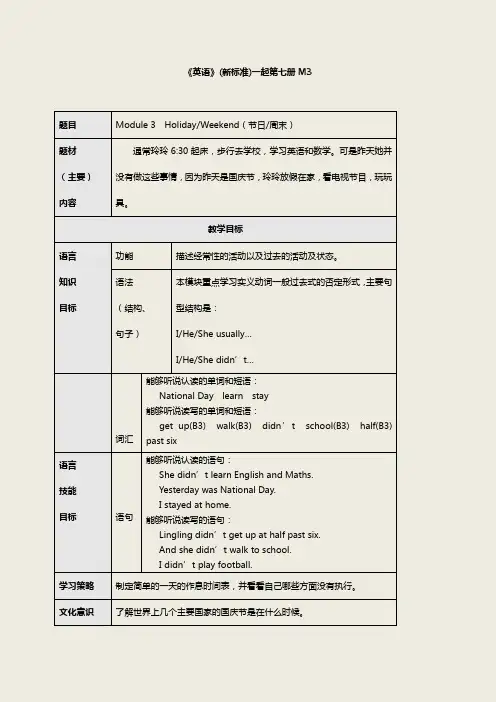
《英语》(新标准)一起第七册M3 题目Module 3 Holiday/Weekend(节日/周末)题材(主要)内容通常玲玲6:30起床,步行去学校,学习英语和数学。
可是昨天她并没有做这些事情,因为昨天是国庆节,玲玲放假在家,看电视节目,玩玩具。
教学目标语言知识目标功能描述经常性的活动以及过去的活动及状态。
语法(结构、句子)本模块重点学习实义动词一般过去式的否定形式,主要句型结构是:I/He/She usually…I/He/She didn’t…词汇能够听说认读的单词和短语:National Day learn stay能够听说读写的单词和短语:get up(B3) walk(B3) didn’t school(B3) half(B3) past six语言技能目标语句能够听说认读的语句:She didn’t learn English and Maths.Yesterday was National Day.I stayed at home.能够听说读写的语句:Lingling didn’t get up at half past six.And she didn’t walk to school.I didn’t play football.学习策略制定简单的一天的作息时间表,并看看自己哪些方面没有执行。
文化意识了解世界上几个主要国家的国庆节是在什么时候。
情感态度培养学生热爱祖国热爱家乡的美好情感。
任务小调查。
发给每个学生一份表格,让学生把上周末和平时的活动填在表格里,如:Name: Wang BinTime Usual Last Weekend7:00 get up didn’t get up9:00 have an English class watch TV14:00 play football didn’t play football16:00 go home paint a picture让学生练习用I usually…But I didn’t…last weekend. I…来比较自己周末和平日不同的活动。
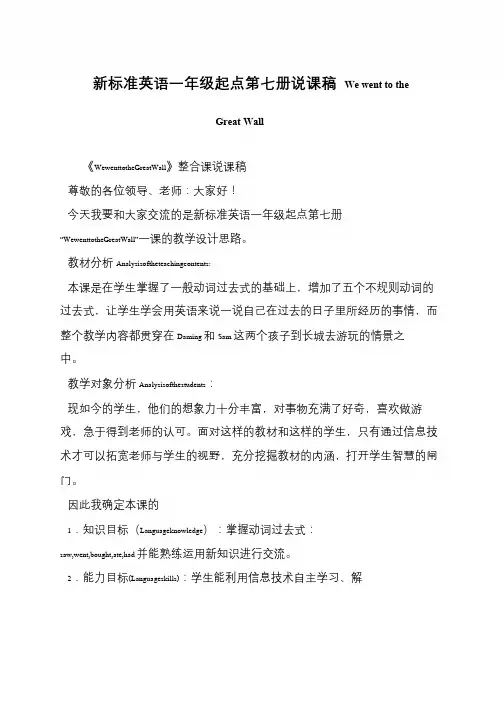
新标准英语一年级起点第七册说课稿We went to the
Great Wall
《WewenttotheGreatWall》整合课说课稿
尊敬的各位领导、老师:大家好!
今天我要和大家交流的是新标准英语一年级起点第七册“WewenttotheGreatWall”一课的教学设计思路。
教材分析Analysisoftheteachingcontents:
本课是在学生掌握了一般动词过去式的基础上,增加了五个不规则动词的
过去式,让学生学会用英语来说一说自己在过去的日子里所经历的事情,而
整个教学内容都贯穿在Daming 和Sam 这两个孩子到长城去游玩的情景之中。
教学对象分析Analysisofthestudents:
现如今的学生,他们的想象力十分丰富,对事物充满了好奇,喜欢做游
戏,急于得到老师的认可。
面对这样的教材和这样的学生,只有通过信息技
术才可以拓宽老师与学生的视野,充分挖掘教材的内涵,打开学生智慧的闸门。
因此我确定本课的
1.知识目标(Languageknowledge):掌握动词过去式:
saw,went,bought,ate,had 并能熟练运用新知识进行交流。
2.能力目标(Languageskills):学生能利用信息技术自主学习、解。
年级起点第七册Module 3 Unit 1She didn’t walk to school yesterday.教学设计教材分析1.语言功能:描述某人过去没有做过的事或行为。
2.教学目标⑴知识目标:掌握单词learn,National Day.掌握并会运用句型;She didn’t walk to school yesterday.⑵能力目标:能够在真实的语言情境中运用本课重点句型,提高语言综合运用能力。
⑶情感目标:在交流中培养合作意识,学会欣赏和评价他人,激发英语学习的兴趣。
3.教学重点用一般现在时和一般过去时对比来介绍发生过的事情。
4.教学难点掌握一般过去时否定句中动词的用法与一般现在时中动词用法的差别,并能在实际生活中运用。
学生分析本班学生英语知识底子较好,许多学生已能很好的掌握一般现在时动词的用法和规则动词的过去式。
他们对卡通人物或是跟他们自身生活相关的信息都非常的感兴趣。
教学过程Step 1. Warm-up.1.Greeting.2.Free talking.T:The National Day is coming. Happy National Day.(Learn the new words:National Day & learn.)Step 2. Presentation.1.T: What do you usually do at National Day,<Student 1>?Elicit: I usually (eat\play\watch\go---).T: What do you usually do at National Day,<Student 2>?And practise the sentences more in class.2.Guessing game.T:What does <Student 1> usually do,do you remember?Elicit:He\She usually does----.(Teacher can help them.)And Student 2\3--?3.Grasp the point and fill in the blanks.⑴Show a picture of my son,T:Look, this is my son,he usually plays ball onMondays, but yesterday he didn’t play ball,he watched TV.⑵Can you fill?(on the small blackboard)This is Yu Dong,she usually (cook\cooks) noodles,but yesterday shedidn’t (cook\cooks) noodles,she washed clothes.Step 3.New Teaching.1.Open their books,and listen to the text,and answer the questions:What doesLingling usually do?Lingling usually gets up\walks\learns--.But yesterday? Lingling didn’t get up\ walk \learn--.2.Listen again,repeat and underline “usually\did n’t”and the verbs.3.Reading the text.⑴Choose your favourite picture to read.⑵Have a reading match between the boys and girls.Step 4.Practice.1.Show some pictures with”√”&”×”,ask Ss to try to describe thepictures.⑴Pictures about Xiyangyang.⑵Pictrues about their classmates.2.Do their Activity Books.To do the E.2&4.Step 5.Summary and homework.BlackboardModule 3 Unit 1She didn’t walk to school yesterday. LearnNational DayLingling usually gets up\walks\learns--.But yesterday? Lingling didn’t get up\ walk \learn--.。
《英语》(新标准)一起第七册M7 题目Module 7 Incidents(事件)题材(主要)内容Tom看电视的时候哭了,大家对发生过的事进行猜测。
大家问他是否摔着了、弄坏了玩具或者看见了什么可怕的东西,Tom说在电视上看见了一只怪物。
教学目标语言知识目标功能猜测别人过去的行为。
语法(结构、句子)本模块重点学习一般过去时的一般疑问句及其回答,主要句型结构是:Did you…? Yes, I did. No, I didn’t.Did he/she…? Yes, he/she did. No, he/she didn’t. 词汇能够听说的单词和短语:good night in fact kiss能够听说认读的单词和短语:monster cry scary(B2)能够听说读写的单词和短语:break toy run(ran) thing(B4) fall(B7M5)语言技能目标语句能够听说认读的语句:Did you see a scary thing?Don’t worry, Tom.The monster wanted to eat the children.能够听说读写的语句:Did you break your toy?Did you fall?Yes, I did. / No, I didn’t.There were three children.学习策略培养学生总结归纳能力,引导学生总结出过去时中一般疑问句的特点和与肯定句不同。
文化意识了解一些外国儿童感兴趣的玩具,与中国的传统玩具进行比较。
情感态度会礼貌的询问别人刚才发生了什么事情。
任务制作表格,采访自己的老师、家人或朋友昨天做过的事情,完成表格,并在小组内部作汇报。
Module 7 Unit 1 Did you break your toy?一、教学目标与要求1、知识与能力目标能够听说读写单词break, fall, see ;能够听说认读单词did, didn’t, cry, monster, scary thing能够听说读写句子Did you…? Yes, I did. No, I didn’t.2、情感态度目标教育学生要做善良的人,当别人伤心难过时应给予安慰。